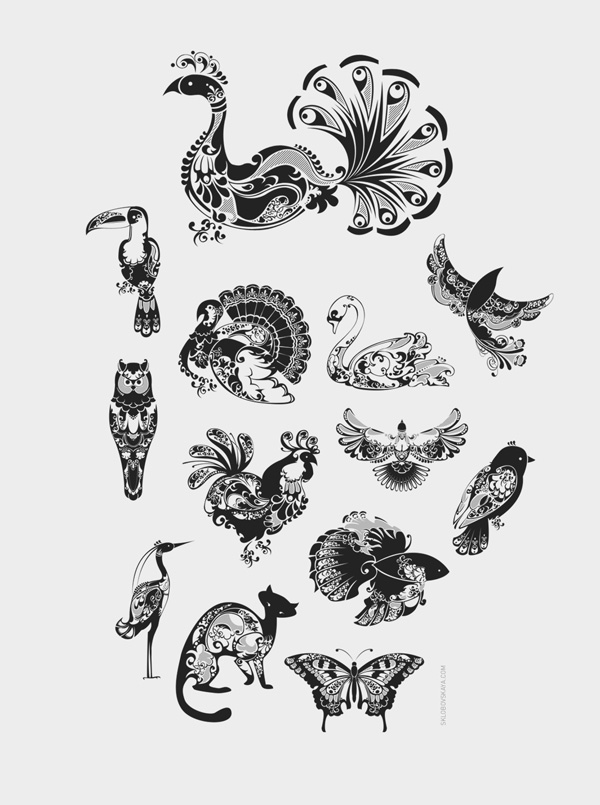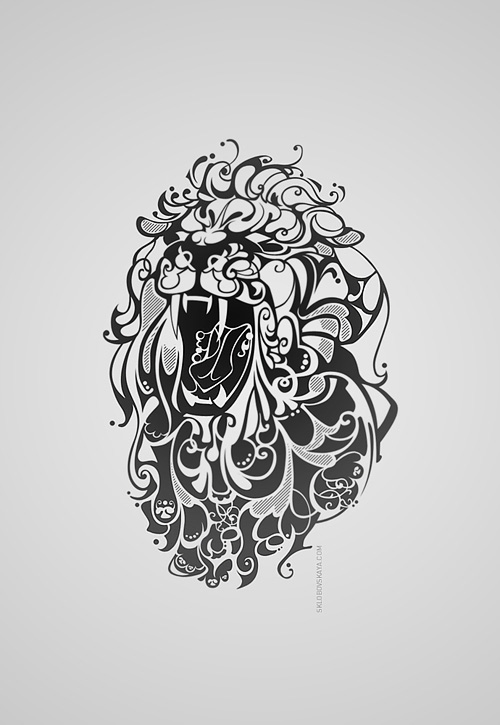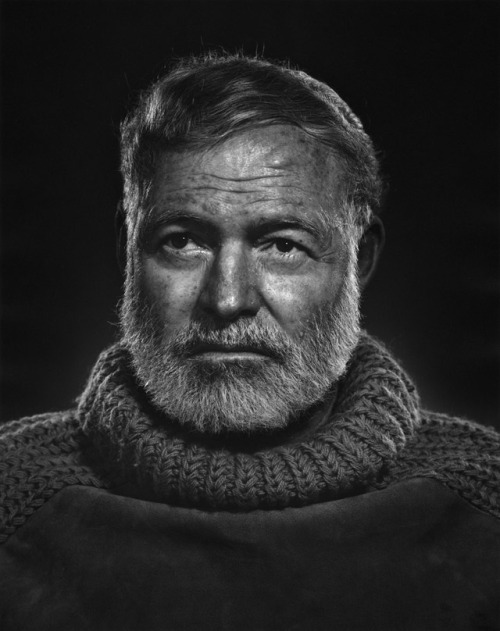Artist Kate McAmon recently spoke at St. Mary's advising art students on the process of going on art residencies and how they can affect your personal artistic style. While she was only a recent graduate from school herself and I initially questioned why I was listening to someone just a few years older than myself who had yet to do anything truly noteworthy, I ended up enjoying her lecture and watching how her art changed and matured dramatically over the course of just a few years.
The first few pieces she showed us were portrait images of herself and her twin brother, and while they showed that she was clearly talented and trying to achieve a unique look for her pieces, they came off as relatively unplanned and messy. When I first saw them I began to regret attending the talk because in my opinion there is nothing worse than listening to someone talk about art that you don't like, especially when it does not even have a concept you find interesting. Luckily she next told us that she worked with narrative oil painter Odd Nerdrum in Norway working on her narrative imagery and attempting to find a balance in her portrayal of the human figure. Nerdrum had a heavy influence on her work and coming out of this first residency her pieces appeared far smoother and more grounded in reality while retaining an inner light and fairytale feel.
Her next residency brought her to Italy where she moved away from her original style completely, choosing to reject the human figure in favor for creating images echoing the scenes of Italy that surrounded her. Her favorite thing to recreate were images of hanging laundry on balconies of homes. She liked the idea of the hanging laundry telling a story about the person who owned them without having to include an actual image of the person themselves.
After she graduated from MICA she returned to her family home to work. She currently is teaching art lessons to students of all ages and working on a new theme in her artwork. Her most recent work uses old photo negatives and recreates them into beautiful small paintings. Changing the size, concept and overall look of her work shows how comfortable she has become in experimenting with her style.
This lecture ended up being an enjoyable lesson in how a person should always try to get as many different experiences and come across as many different opinions on how something should be done in order to make themselves as skilled as possible in what they want to do. This was nice because it was able to applied to a wide range of interests and not only applicable to people who wanted to work in studio art.
Saturday, May 4, 2013
Tuesday, April 23, 2013
Website Links
Get Lost: http://students.smcm.edu/klharn/get%20lost/getlost_home.html
Website: http://students.smcm.edu/klharn/
Website: http://students.smcm.edu/klharn/
Tuesday, April 16, 2013
Website Inspiration
The internet is full of useful websites that can give their visitors plenty of useful information, but I find myself drawn to websites that exist purely for the purpose of being useless. People seem to take the internet too seriously, I see fights break out on all kinds of websites and it baffles me that there are so many people in the world that can get so enraged over something someone wrote online. I would like to remind people that while the internet can and should serve as a functional tool in today's society that does not mean that there is no room for humor, pleasure, stupidity, and uselessness. With that in mind I came across several websites that simply exist, they do not take themselves seriously and therefore allow the visitors to not take them seriously either.
1. fallingfalling.com
This site treats the viewer to endless fields of color collapsing one after another on top of themselves with a haunting noise in the background. I enjoy it not only for its appearance to be useless, but also because the vast array of colors and abstract shapes appear very artistic and also soothing. I spent several minutes watching the repetitive falling colors and moving my mouse around attempting to figure out if there was any way that you could control or alter the site (I'm pretty sure there is not).
2. staggeringbeauty.com
This website introduces the visitor to an animated character with almost no features. He is a black cylinder with two white eyes that are the only sign that he is in fact a living character. Moving your mouse across the page controls the direction that he wiggles in, and moving your mouse around very quickly causes him to appear to go into what I can only assume is an epileptic fit. I really enjoy the simplicity of the character combined with the very simple background, and the immense changes that take place after the visitor is prompted to shake their mouse.
3. drunkronswanson.com
This site loops a gif of the character Ron Swanson from the television show Parks and Recreaction. Along with the infinite scene of a fully grown man drunkenly dancing in a tiny top hat the viewer gets to listen to a loop of the song "Who Dat Girl" by Flo Rida. This site has no real interaction except for one link in the top left corner that takes you to theinternetfireplace.com, yet another seemingly useless site.
Links: http://www.fallingfalling.com/
http://www.staggeringbeauty.com/
http://www.drunkronswanson.com/
1. fallingfalling.com
This site treats the viewer to endless fields of color collapsing one after another on top of themselves with a haunting noise in the background. I enjoy it not only for its appearance to be useless, but also because the vast array of colors and abstract shapes appear very artistic and also soothing. I spent several minutes watching the repetitive falling colors and moving my mouse around attempting to figure out if there was any way that you could control or alter the site (I'm pretty sure there is not).
2. staggeringbeauty.com
This website introduces the visitor to an animated character with almost no features. He is a black cylinder with two white eyes that are the only sign that he is in fact a living character. Moving your mouse across the page controls the direction that he wiggles in, and moving your mouse around very quickly causes him to appear to go into what I can only assume is an epileptic fit. I really enjoy the simplicity of the character combined with the very simple background, and the immense changes that take place after the visitor is prompted to shake their mouse.
3. drunkronswanson.com
This site loops a gif of the character Ron Swanson from the television show Parks and Recreaction. Along with the infinite scene of a fully grown man drunkenly dancing in a tiny top hat the viewer gets to listen to a loop of the song "Who Dat Girl" by Flo Rida. This site has no real interaction except for one link in the top left corner that takes you to theinternetfireplace.com, yet another seemingly useless site.
Links: http://www.fallingfalling.com/
http://www.staggeringbeauty.com/
http://www.drunkronswanson.com/
Tuesday, April 2, 2013
Reading Response: Vito Acconci
In the reading by Vito Acconci the author strives to convince us that we are living in a world where we are controlled by time and city planners alike, and that we must rebel from our modern culture to find a simpler, happier, and truer way of life.
While I will admit that this reading was quite entertaining and Acconci brought up many points that were nice to mull over in your head, a lot of the reading felt unoriginal and too self important. The way Acconci wrote reminded me of a lot of kids that I went to high school with that would rattle off all of the conspiracy theories that they were able to read online. At some point you just lose interest in what they are talking about, and that only makes them spew out even crazier and more abrasive ideas. There have been plenty of authors that have written about their disenchantment with modern society, and I feel as though Acconci is almost riding on the coattails of people in the early twentieth century that first started complaining about their fears of how modernism would negatively impact society.
With that being said there are parts of his essay that I liked reading and had to think about longer. In paragraph six he writes that while many people gather in a public space, they do not behave as though they are one public. Groups stick together and do not mingle with other groups. People are everywhere, especially in the city, you cannot go anywhere without at least passing people, more often having to sidestep them and struggle to keep a fast pace while trying not to accidentally touch anyone else. You rarely have any real human interactions with all of the people you are surrounded by. This reminds me of the themes Georges Seurat was going after in his painting "Sunday Afternoon on the Island of La Grande Jatte". Seurat wanted to show how he was afraid that the modern practice of going out to "see and be seen" was causing more people to come out in public space but less human interactions between the people. This shows how people both at the end of the 19th century and people in the 1980's both feared of a loss of human connection.
While I will admit that this reading was quite entertaining and Acconci brought up many points that were nice to mull over in your head, a lot of the reading felt unoriginal and too self important. The way Acconci wrote reminded me of a lot of kids that I went to high school with that would rattle off all of the conspiracy theories that they were able to read online. At some point you just lose interest in what they are talking about, and that only makes them spew out even crazier and more abrasive ideas. There have been plenty of authors that have written about their disenchantment with modern society, and I feel as though Acconci is almost riding on the coattails of people in the early twentieth century that first started complaining about their fears of how modernism would negatively impact society.
With that being said there are parts of his essay that I liked reading and had to think about longer. In paragraph six he writes that while many people gather in a public space, they do not behave as though they are one public. Groups stick together and do not mingle with other groups. People are everywhere, especially in the city, you cannot go anywhere without at least passing people, more often having to sidestep them and struggle to keep a fast pace while trying not to accidentally touch anyone else. You rarely have any real human interactions with all of the people you are surrounded by. This reminds me of the themes Georges Seurat was going after in his painting "Sunday Afternoon on the Island of La Grande Jatte". Seurat wanted to show how he was afraid that the modern practice of going out to "see and be seen" was causing more people to come out in public space but less human interactions between the people. This shows how people both at the end of the 19th century and people in the 1980's both feared of a loss of human connection.
Tuesday, March 26, 2013
Thursday, March 21, 2013
Wednesday, March 6, 2013
Thursday, February 28, 2013
Natalie Slobovskaya
Natalie Slobovska is an artist working in a wide variety of mediums, and enjoys the images she is able to create using illustrator. She graduated from the School of Art and Design at Washington University in St. Louise. She is very interested in history, literature, and world cultures and incorporates these interests into her art.
In "Vector Pictograms" above, Slobovskaya wanted to translate the image style of traditional Slavic lore and Native American symbols into digitally created vector images.
She advertises her love for literature through a poster she created inspired by Charles Dickens "A Christmas Carol" which is being used by Subplot Studio theater company.
Overall her work exemplifies the limitless possibilites and styles that can be created through illustrator. She also shows how you can find inspiration through anything, regardless of whether or not you think it is an "artistic" idea.
 |
| Vector Pictograms |
She advertises her love for literature through a poster she created inspired by Charles Dickens "A Christmas Carol" which is being used by Subplot Studio theater company.
 |
| A Theatrical Poster Design |
 |
| Vector Lion Poster |
Wednesday, February 20, 2013
Tuesday, February 19, 2013
Portrait Photographs
Tony Robbin
Tony Robbin is a native Washington DC artist exploring the medium of computer visualizations. His works focus on patterns generated from algorithms. He attempts to show what fourth- dimensional space looks like using combinations of two and three- dimensional forms. The end result echoes the appearance of cubist art work, but with incredibly careful geometric precision.
 |
| Drawing 53, 2004 |
 |
| Persian, 1973 |
As he continued his work he developed a patent for the application of quasicrystal structures in architecture, or figures that repeat themselves to fill a space but are not traditionally symmetrical. He also has created programs for "realtime rotation" in four- dimensional space, allowing viewers to immerse themselves in a sense of space that would normally be inconceivable to them.
Robbins art gives another example to the art world that mathematics and art can be joined in a functional and aesthetically pleasing way. His early paintings show a desire to give art guidelines, or an arithmetical exactitude, and his later computer visualizations manage to capture the perfection you can see he strove for. His creativity in merging technology and aesthetics can only grow in popularity as time continues.
 |
| 2004- 4, 2004 |
Monday, February 11, 2013
Tuesday, February 5, 2013
Julius von Bismarck
Julius von Bismarck is an artist interested in changing the way the public views their everyday world. He uses a number of mediums and ideas in an attempt to alter our usual perceptions of the space around us. At only 29 years old, he is currently working at CERN, the largest particle physics research center in the world, as an artist making connections between art and theoretical physics. Many of his projects use digital information and technology to change what the viewer sees. In his "Public Face" series, von Bismarck mounted huge faces above the cities of Berlin and Lindau and used facial recognition software to change the expression on the face depending on the average expression of people in the city.
 |
| Public Face I in Berlin |
In one of his most popular projects, called the "Image Fulgurator", von Bismarck is able to add whatever image he would like inside the photographs of people around him.
 |
| Von Bismarck with the Image Fulgurator |
The device was named after the Latin word for lightning, which is "fulgur", and according to von Bismarck means "the flash thrower". This is because the fulgurator works by projecting an image onto an object or person that is only visible after someone takes a photograph of it using flash. This allows him to add his own message to popular tourist attractions or political speeches. In one of his cleverest uses of the fulgurator, von Bismarck projects the logos of companies onto the politicians they sponsor, photographically branding them with the symbol of their keepers.
 |
| (Mayor of Berlin) Wowereit powered by "O2" |
Von Bismarck has a patent for his invention, but he is still worried that it will be used for the wrong purposes by others in the future, specifically advertising companies. he says that he has been offered "a lot of money for it, but [his] intention is for it to present the opposite side."
I believe that von Bismarcks invention is a powerful force for individuals to get a chance to put their own opinion onto usually untouchable subjects in a way that is both effective and fairly innocent. I share his fears that in a few years no one will be able to travel anywhere and take a picture without some companies logo or slogan appearing in the photograph, but as long as it is used by the general public as their own form of commentary I think it is doing something progressive and important.
Tuesday, January 29, 2013
Image Corrections
 | |||||
| Before |
 |
| After |
 |
| Before |
 |
| After |
 |
| Before |
 |
| After |
 |
| Before |
 |
| After |
24 Hour Technology Log: Sunday, January 27
10:42- Check phone
11:07- Swipe ID for meal
11:26- Use phone
11:32- Scan ID to enter suite
11:41- Check email on computer
12:36- Use debit card
1:17- 2:48- Computer Use
4:41- Use phone
5:22- Swipe ID for meal
6:19- Scan ID to enter suite
9:03- Scan ID to enter Mac Lab
9:05- 9:51- Computer Use
9:54- 10:38- Phone Call
10:40- Scan ID to enter suite
10:56- Check email on computer
11:32- Set alarm on phone
11:07- Swipe ID for meal
11:26- Use phone
11:32- Scan ID to enter suite
11:41- Check email on computer
12:36- Use debit card
1:17- 2:48- Computer Use
4:41- Use phone
5:22- Swipe ID for meal
6:19- Scan ID to enter suite
9:03- Scan ID to enter Mac Lab
9:05- 9:51- Computer Use
9:54- 10:38- Phone Call
10:40- Scan ID to enter suite
10:56- Check email on computer
11:32- Set alarm on phone
Monday, January 28, 2013
Thursday, January 24, 2013
Subscribe to:
Posts (Atom)







































